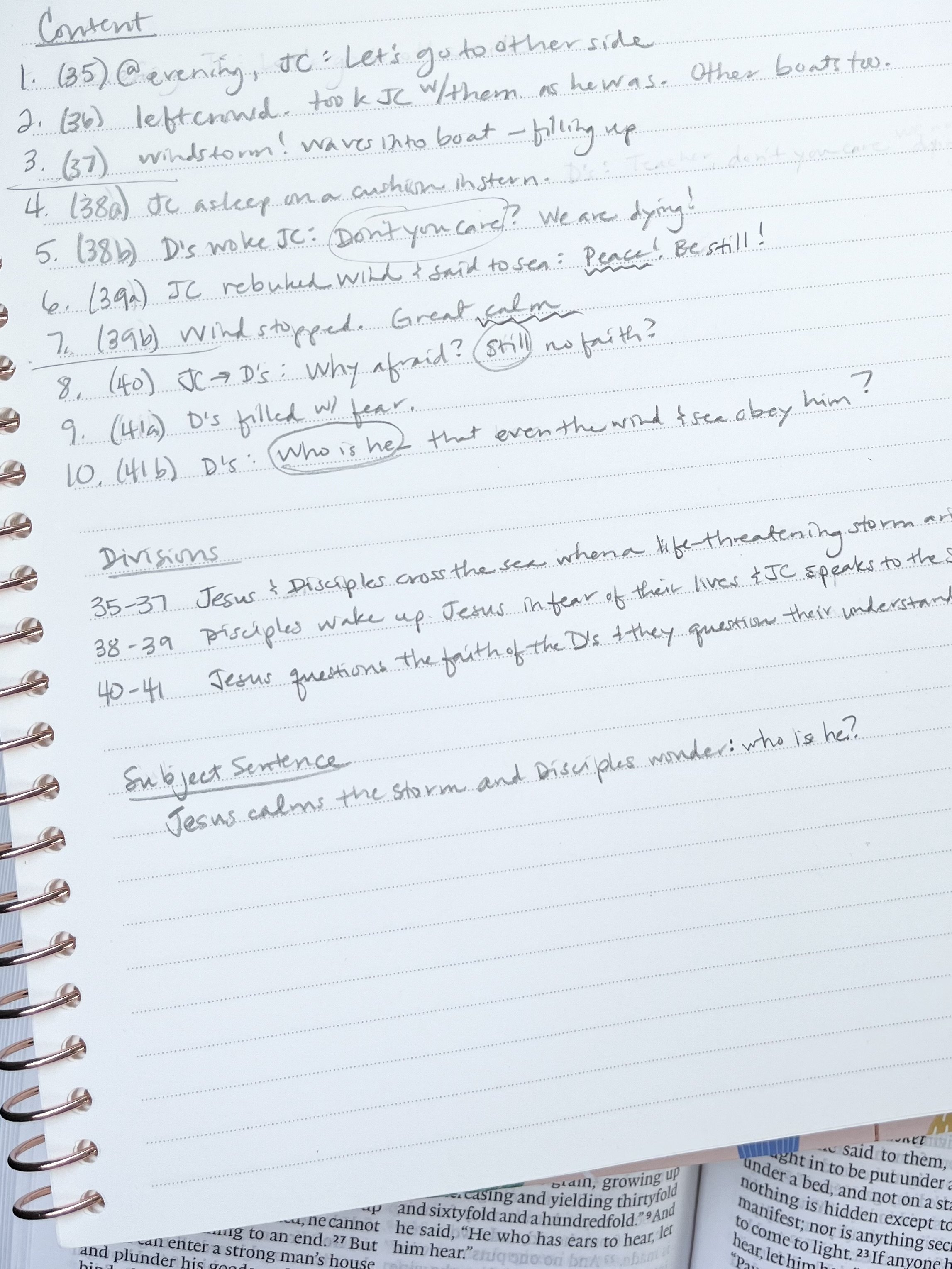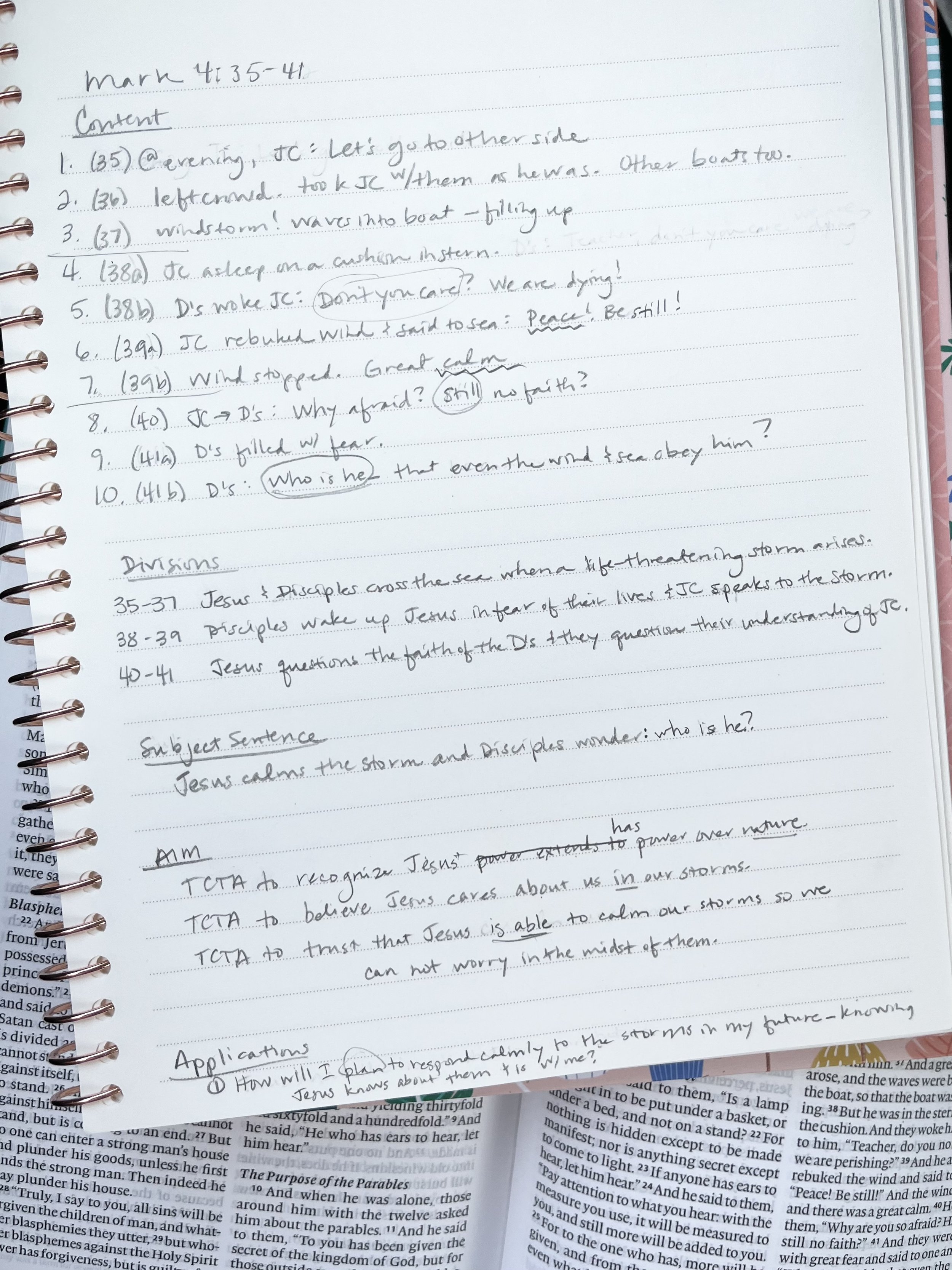Bible Study Methods: Homiletics — Nicole O'Meara
“If you can’t explain it to a six-year old, you don’t understand it yourself.” - Albert Einstein
In college I took several Bible classes. I loved each one but I wonder how much I really learned because, like the saying goes, I could rarely take what I learned and explain it simply. It wasn’t until I starting attending Bible Study Fellowship that I learned to whittle a section of scripture down to its facts, themes, and applications in a way that made it possible to explain to others. BSF’s founder, Ms. Wetherell Johnson, used Homiletics while she served on the mission field in China. In the 50s, she taught it to the very first BSF members in a living room in Southern California and it continues to be taught as part of the BSF curriculum around the world today. In my opinion, that makes Homiletics a classic method of Bible study — one that is still relevant and useful today.
What is Homiletics?
Homiletics is a fancy word that means “the art of preaching.” To study the Bible using Homiletics means to break down a passage to learn the specific facts, themes, truths, and applications such that, by the time you finish you could teach it. This is an excellent way to study!
There are specific steps to Homiletics and none can be skipped. If you are a structured learner, you will love this. If you learn best in a more organic way, you may not like it but it still worth learning. There are many benefits to doing Homiletics, the most important being that you will learn directly from the Word of God. No preachers, teachers, commentaries or extra-biblical resources are needed.
Pros to Homiletics:
Can be used to study large and small scripture passages
The Bible and the Holy Spirit (and paper and pen) are the only necessary resources
Applications are specific to your current life
Cons to Homiletics:
Highly structured — steps cannot be skipped
Takes time
Uses summarization skills (This can be a stumbling block for some people, especially students. I will give you tips to make this easier.)
In this article, I will outline the specific steps to Homiletics, then I will show you how I used them to study Mark 4:35-41.
Making A Homiletical Outline
Think of these steps as a hourglass. Starting at the top, you look wide for facts, lots of facts. As you go further, you narrow your focus on the facts until at the most narrow point of the hourglass, you can make one summary sentence that encompasses the entire passage. Then, you begin to look wider, broader. What do those facts teach you about God, man, sin and the world? How does the passage display one universal truth? (There can be more than one.) Finally, at the widest part of the hourglass, you search out applications to your life today, which may be one or many.

As with all Bible study methods, begin with prayer. Ask the Holy Spirit to illumine the Word and guide you in understanding. That is a prayer he delights to answer (John 16:12-15).
Content List:
Using only facts and words from the passage, restate the passage in 10 roughly equal segments. Sentences are not necessary. Words aren’t necessary if a symbol will do. (Below, you’ll find a list of common symbols you can use.) This section is just for you, it doesn’t need to follow grammar rules or make sense to someone else. The more you can boil down the verses into small pieces, the better your mind can comprehend and contain it. Think of the WWWWH questions:
Who is in the this verse?
What is happening?
When is it happening?
Where is it happening?
Why is it happening? (Only answer the “why” if it is explicitly stated in the verse. Don’t jump to conclusions yet.)
How is it happening?
Divisions:
Split the content list into 3-5 divisions, aiming for less. Review your content list and notice where there are natural splits in the narrative. If you don’t see natural divisions, look at the way your Bible has divided the verses. Are there paragraph breaks? Headers? Chapter breaks? Notice those and see if a division in your Content List might make sense in the same places. Make one summary sentence for each division, include the beginning and ending verses.
Tip: If you struggle to summarize, try it verbally first. Speak the facts of a segment into a sentence and listen to how it sounds. Often times, taking the writing out of this step can help your brain whittle down the passage further. Another helpful tip is to go back to the WWWWH questions and make a sentence out of the facts. Finally, if those don’t work for you, imagine you are journalist trying to describe the scene in a newspaper article. How would you describe it?
Subject Sentence:
This is the narrowest part of the hourglass. Write one summary sentence with a max of 10 words.
How? Look at your Divisions and ask yourself: At its essence, what is this passage about? Stay with the facts! We’re not ready yet to draw conclusions or connections with other scripture passages. It doesn’t have to be pretty, or even grammatically correct. Numbers as symbols don’t count as part of the 10 words. My Subject Sentences often start with the name of the main character, God, or Satan/sin. Those are the main actors in every scripture passage. If you struggle in this step, go back to your Content List and find repeated words. Underline or highlight them. See if those words help clarify what the passage is about. Can you use/repeat those words in your Subject Sentence? If so, you are on the right track.
Tip: Once you’ve written your sentence, read it out loud and ask yourself (or someone else) if they can spot where the passage is located in the Bible? A rough guess is fine. If you can’t, then your Subject Sentence isn’t specific enough. Try again. For example, where do you think this passage can be found?
Paul urges Christians to hang on in hard times?
Not sure? That’s because it’s vague. Paul makes this argument several times and in several ways in all of his letters. How about this sentence?
Paul urges Corinthian believers to endure affliction for Jesus’ sake.
We’re you able to at least guess that this is from First or Second Corinthians? That’s a really good start. It’s from 2 Corinthians 4 and you probably could have gotten there eventually by the use of the word “affliction.”
Aim:
Now, like the hourglass, we can begin to move outward. We will go beyond the facts and widen our understanding. Remember, Homiletics is the art of preaching, so, write one sentence that might begin with “My aim is to cause the audience to …” You may want them to learn something that’s true. You may want them to see something in a new way. You may want them to be reassured of a truth they already know. This isn’t the time to be concerned with taking action, although that may be an aim. This is the time to focus on learning a timeless truth that applies to life. I often write two or three aims before I get to what I really want to learn/teach/believe.
So, at this point, we need to discover what timeless truth is being taught in this passage. A timeless truth is something that is true in all ways for all time. Here are some questions I ask myself to find the timeless truth:
What is true about God in this passage?
What is true about man in this passage?
What is true about sin in this passage?
You may come up with a few truths. That’s ok. One of them will standout to you and that’s the truth you will teach to yourself, or to those little munchkins at Sunday school, or to a group of teenagers, or to a small group of adults, or even to an auditorium filled with adults on retreat.
Applications:
Finally, action. Looking at your aim and ask yourself: What action might God be asking you to take based on that timeless truth? Try to use the SMART model for your applications:
Specific - Use specific words like names, places, and days of the week.
Measurable - How will you know if you’ve progressed in this application?
Achievable - Choose an application that can actually be done. You might think of a goal like, “I will share the gospel with ten people each day.” That goal may not be achievable if you don’t interact with ten people every day of the week. Instead, try, “I will look for an opportunity to share the gospel once this week.” Whether it’s in line at the grocery store or in a text with a long-distance friend, the likelihood of having at least one opportunity in a week is actually possible.
Relevant - Looking again at the first application above, “I will share the gospel with ten people each day,” ask yourself: Is sharing the gospel relevant to the Aim of this passage? If not, find a new application that is relevant.
Time-bound - Make your application set for the near future. When we are specific about the action and the timeframe, it is much easier to see when, where, and how God helped us. Again, in the above example, sharing the gospel with one person is vague and open-ended. But sharing the gospel with one person this week is time-bound. By the end of the week, you can look back and evaluate the opportunities that came and went and how you handled each one.
Example of a Homiletical Outline
Now, let me show you my Homiletical outline for Mark 4:35-42.

My Content List and Divisions. Notice the eraser marks. I use pencil because Homiletics is a work in progress. In the Content List, I start by numbering each line 1-10. I force myself to use only one line per segment. It becomes more challenging in a much larger passage… a good challenge. Notice also that I list the verse number on each line. In a larger passage, those would be several verses per line. Also notice the circles around words that I wanted to be sure I used in the Divisions or at least focus on in the Aim.

My Subject Sentence. I went back to the Content List and underlined key words I wanted to repeat in the SS.

My Aim. “TCTA” is my shorthand for “To cause the audience to…” Notice, I wrote three Aims. I like #2 and #3 but I would probably wait until I had my Applications written before I chose which Aim I wanted to use to teach this passage.


My Applications. In the end, what meant the most to me in this passage was that Jesus was with the Disciples. So, if I taught this passage today, I would choose Aim #2 and I’d probably write more applications for each Division that focused on the nearness of God in our storms.
FAQ about Homiletics
Q: How do I choose a passage of scripture? Where do I start and stop?
A: You have options. One way is to choose one chapter of a book of the Bible at a time.
Another way… if your pastor is preaching through a book of the Bible, you can do your own homiletics on the passage that is coming up on the next Sunday or the passage he just preached on last Sunday.
If you are reading through a Bible reading plan, take the first verse of the week and the last verse of the week and make that your homiletics passage.
Some Bible teachers make plans with ready-made passage breaks. I like Anne Graham Lotz’s plans.
Q: What are some common symbols to use in the Content List?
A: Here are just a few. You can get creative here.
Omega = God
Cross = Jesus
Arrow = went to /goes to / traveled to / spoke to
Colon = said
Sun = sun, day/dayime
Moon (like a crescent) = night/evening
Q: Do you do Homiletics every day?
A: No. When I teach a passage of scripture, I study the verses daily in a variety of ways, a few verses each day. Next, I do Homiletics, then read one or more commentaries to fill in my understanding, and finally write my talk using my Homiletical outline as the outline for my talk.
Homiletics Lite
A simplified version of Homiletics involves asking 3 questions, thus it is called “The 3-Question Method.” (See Anne Graham Lotz again.) I like to call this “Homiletics Lite” and it works very well when I’m teaching teens or people who have not read through and studied the passage before I teach it. As we walk through the passage together verbally, the study becomes less academic and more conversational — something magical happens and the Word becomes alive. Some of my most favorite Bible study moments happened while leading high schoolers through a 3-Question Method conversation. When one of them had an “ah-hah” moment, the stars shone brighter and my heart soared.
The Steps:
Begin with prayer. Then read the passage out loud so everyone’s on the same page.
Ask: What is this passage about? Who is in the scene(s)? Where is it happening? When? You might pretend to be an investigative journalist looking to report the facts. “Just the facts, ma’am.” Or you might pretend to be a reader who got dropped into a story and needs to learn quickly who the main characters are and what they are about.
Ask: What is universally true in this passage? True for everyone and for all time? This will probably be something true about God, man, and/or sin. There may be many universal truths or there may be only one.
Ask: What can I do right now because I learned this truth? It might be that you need to confess a sin. Or pray for a new desire that aligns with God’s desires. It might be speaking to a certain person about a certain thing. Or perhaps you need to make a decision. This will be unique to each person and very much, Holy Spirit-led. Write down your personal application action.
Your Turn
I hope you give Homiletics a try. I’m biased, but I truly believe it is the best way to study the Bible and learn what God has for you personally in it.
Have you used the Homiletics method of Bible Study? What are your thoughts on it? Do you have any tips to help a newbie?
I created a list of 12 Verses to Help You Endure for when you are in a storm.
Let me send it to you today.





